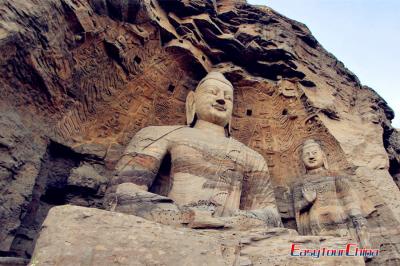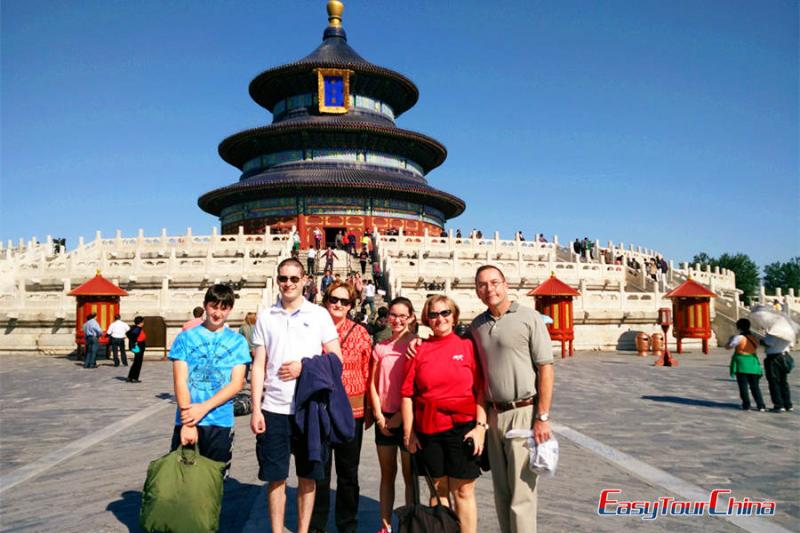Temple of Heaven
One of the most important temples in China The Temple of Heaven (Tiantan Park) is an imperial complex Taoist buildings situated in the southeastern part of central Beijing, Chongwen District. The name literally means an altar to worship the heaven. In Ming and Qing Dynasties, the Emperors would visit here at a specific time for annual ceremonies of prayer to Heaven for good harvest.
Beijing Tiantan was first built in 1420, and reconstructed in 1530, encompassing 273 hectares. The perimeter of the complex is 6369 meters long and 6 meters high. This dignified complex of fine cult buildings is surrounded by old pinewoods. In its overall layout, you will find that it symbolizes the relationship between earth and heaven, the human world and God's world, which stands at the heart of Chinese cosmogony, and also the special role played by the emperors within that relationship. in 1998, the Temple of Heaven: an Imperial Sacrificial Altar in Beijing was inscribed as a UNESCO World Cultural Heritage Site.
Nowadays, Temple of Heaven is a masterpiece of architecture and landscape design, which simply and graphically illustrates a cosmogony of great importance for the evolution of one of the world's great civilizations. It is also a must-visit for anyone who travel in Beijing.
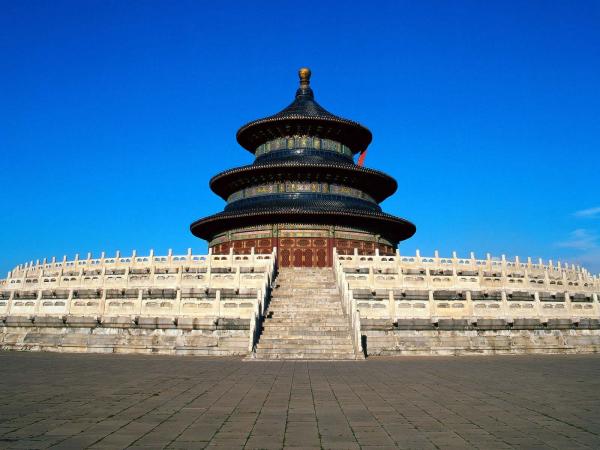
Beijing Temple of Heaven Facts
More Interesting Facts about Temple of Heaven
1. How big is the Temple of Heaven? The area of the Forbidden City is about 720,000 square meters, and the area of the Temple of Heaven is about 2,730,000 square meters, which is equal to about 3.8 Forbidden City. The outer wall of the Temple of Heaven has not yet been fully restored because it is too long.
2. Almost all architectural numbers are related to "9", as it is the symbolic number of the Heavenly Emperor. For instance, the Circular Mound Altar has nine steps, and each floor tile is a multiple of nine.
3. The pillars in the Hall of Prayer for the Year conceal the “time code”: 4 golden pillars represent the four seasons, 12 red pillars symbolize the 12 months, and 12 gable pillars correspond to the 12 hours of the day in ancient China. The total of 28 pillars symbolize the 28 stars in the sky.
4. The Hall of Prayer for Good Harvests is supported entirely by mortise and tenon construction without a single nail. It has survived many earthquakes (including the 1976 Tangshan Earthquake).
5. The Danbi Bridge (丹陛桥), which is 360 meters long, is a special path for worshipping Heaven. The stone-paved path in the middle is called the "Divine Way", and only the Heavenly Emperor and deities can walk on it. The "Imperial Way" on the left is for the emperor to follow, and the "Royal Way" on the right is for the civil and military officials to follow.
6. Every year at noon on the winter solstice, the plaques of the Imperial Vault were exposed to direct sunlight, and the shadows of the plaques fell right in the center of the incense burner below -- a phenomenon used by the people to calibrate the seasons.
7. During the Ming and Qing dynasties, the Temple of Heaven planted a large number of mugwort and mint. It not only prevented insects, but also allowed the emperor to smell the fragrance when offering sacrifices to heaven, creating an atmosphere of “heavenly wonderland”.
8. When the Eight-Power Allied Forces occupied Beijing in 1901, some of the outer walls of the Temple of Heaven were torn down to build a railroad for the purpose of transporting materials. The remains of the railroad tracks are still visible today.
9. Fuyan (serving Beijing cuisine with roast duck) at the West Second Gate of the Temple of Heaven is one of the few restaurants in a park in Beijing (there are also Tingli Pavilion, Beihai Fangshan and Qingfeng Baozi in the Summer Palace).

History: When Was the Temple of Heaven Built
As China's largest existing ancient sacrificial complex, the construction of the Temple of Heaven took a lot of manpower, material and financial resources. Its location, layout and architectural design all have profound cultural connotations and symbolism. Understanding its history, one can know how old is the temple of heaven, who built it, and why was it built.
In the 18th year of the Ming Yongle (1420), Zhu Di, Emperor Chengzu of the Ming Dynasty, moved the capital to Beijing and built the Temple of Heaven and Earth (the original name) according to the rules of the Temple of Heaven and Earth in Nanjing. It included the Great Sacrifice Hall, the Great Sacrifice Gate, and the Huangqian Hall, which were places of worship for Heaven and Earth.
In the ninth year of the Ming Dynasty (1530), the “Great Rites” incident occurred, and Emperor Zhu Houzhong of the Ming Dynasty decided to restore the old system of dividing heaven and earth into separate rituals. Huanqiu was built in the south of the Hall of Great Sacrifice, and the ceremony was held on the winter solstice. In the same year, the Temple of Heaven and Earth was renamed the Temple of Heaven.
In the 16th year of the Qianlong reign of the Qing Dynasty (1751), Emperor Qianlong issued an edict to change the Daxiang Hall into the Hall of Praying for Good Harvests and the Daxiang Gate into the Gate of Praying for Good Harvests.
In the 15th year of the Guangxu reign of the Qing Dynasty (1889), the Qinian Hall was destroyed by lightning and fire. It was rebuilt the following year and took six years.
>> Recommended 1-day Beijing Tour to Forbidden City and Temple of Heaven
The Layout and Architectures
The main ancient buildings of China's Temple of Heaven are located in the inner Altar. In the middle of the inner altar, there is an east-west partition wall that divides the inner altar into the south and north parts. It is composed of three groups of ancient architectural complexes: the Circular Altar, the Prayer Altar and the Fasting Palace. The Prayer Altar is located in the north of the Inner Altar, while the Circular Mound Altar is in the south. The Zhai Palace is located in the west of the Inner Altar. A 360-meter-long, 28-meter-wide and 2.5-meter-high Danbi Bridge connects the Circular Mound Altar and the Prayer Altar. The inner altar is surrounded by the East Heavenly Gate, the North Heavenly Gate, the West Heavenly Gate, the Guangli Gate, the Zhaoheng Gate and the Taiyuan Gate.
To the north of the Circular Mound Altar lies the Imperial Dome. It is surrounded by a perfectly circular wall with a smooth and flat surface. Sound waves can be transmitted through the wall, and it is commonly known as the "echo wall".
The outer altar of the BeijingTiantan Park is a forest area with a large number of trees planted. To the south of the west of the Outer Altar, there is a Divine Music Department, which is a place for music and dance rehearsals and is commonly known as the Temple of Heaven Taoist Academy. >> Check out Temple of Heaven Map
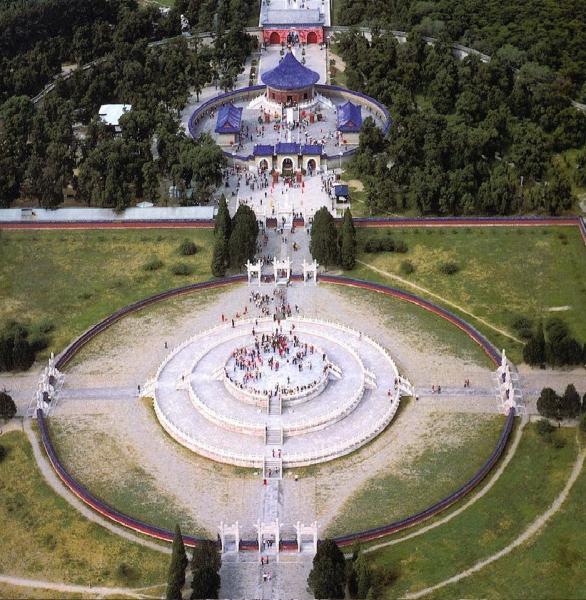
The Sacrificial Ceremonies - What Was the Temple of Heaven Used for
Heavenly Sacrifice
The ceremony of Heavenly Worship was very grand and complicated, and required a lot of preparations in advance. During the ceremony, the emperor would offer sacrifices to the god of heaven, praying for the god of heaven to bless the country with good weather and stability. The whole process was full of mysterious and solemn atmosphere.
Pray for a Good Harvest
It is held in the Hall of Prayer for Good Harvests on the first day of the first lunar month every year. The emperor would pay more attention to praying for agricultural production.
>> Recommended 4-day private Beijing Highlights Tour
What to See
The three major structures in the complex include Hall of Prayer for Good Harvests, Imperial Vault of Heaven (with Echo Wall), and Circular Mound Altar.
The Hall of Prayer for Good Harvests
It was used to worship earth and heaven in winter solstice, and pray for good harvest in early spring. It is a round hall with a triple-eave roof with blue glazed tiles, culminating in a gilded sphere. The Hall of Prayer for Good Harvests is 38.2 meters high and 24.2 meters in diameter. The interior design respectively symbolizes the four seasons, the twelve months, the twelve hours of the day and the stars in the sky. It is the only remaining example of ancient Mingtang-style architecture.
The Imperial Vault of Heaven
Built in the ninth year of the Jiajing reign of the Ming Dynasty (1530), It is made from wood, 19.5 meters high and 15.6 meters in diameter. The excusive wooden structure with a blue glazed tile roof, and a glided sphere on the top, makes it elegant and majestic.
Echo Wall
It is a circular surrounding wall of the Celestial Warehouse, 3.72 meters high, 0.9 meters thick, 65.2 meters in diameter, 205 meters in circumference and covering an area of 3,336 square meters. If two people respectively stand behind the wall of East & West Annex Hall, one speaks with his/her face toward north, the other put his/her ear to the wall, and then they can hear each other’s voice clearly.
The Circular Mound Altar
Also built in 1530, It is a triple-tiered outdoor circular platform made from white marble stone. It was used by emperors to hold the sacrificial ceremonies to the heaven on Winter Solstice. The number of stone steps for the altar, the top stones of each layer and the stone balustrades of the Circular Mound Mound are all in the form of nine and multiples of nine to represent the "Nine Heavens". By repeatedly using the number "nine", the supreme position of heaven is emphasized.
Today’s Temple of Heaven
As a World Heritage Site, the Temple of Heaven is no longer a forbidden place for the royal family. What is the Temple of Heaven used for today? It is the Tiantan park for the local people of Beijing and one of the best things to do for Beijing tours. It retains a solemn sense of history, but is also full of the flavor of life. From 6 to 8 in the morning, on the Danbi Bridge, old Beijingers practice Tai Chi, spin tops and kick shuttlecocks. At the North Gate, there are often Peking Opera enthusiasts who practice their voices.
During traditional Chinese festivals such as the Mid-Autumn Festival and the Spring Festival, the Temple of Heaven hosts a light show at night. For international tourists, playing Tai Chi at the Temple of Heaven or taking photos in the Hall of Prayer for the Year of the Dragon in Chinese dress is a great experience.
>> Recommended 4-day Beijing Private Tour for Women
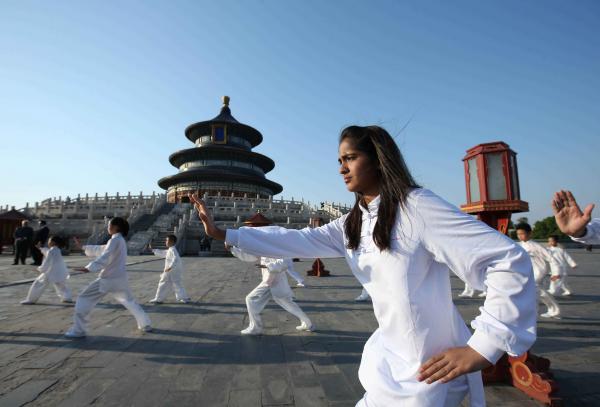
When to Visit
Best time for visit: all year round.
Opening Hours:
Gate:6:00 – 22:00
The scenic spots inside the Temple of Heaven:
From March to June: 8:00 – 17:30
From July to October: 8:00 – 18:00
From November to February: 8:00 - 17:00
Temple of Heaven Tickets Prices
| Ticket Type | Price (CNY) |
| Peak Season Ticket | 15 |
| Peak Season Combo Ticket (includes entrance + Hall of Prayer for Good Harvests + Echo Wall & Circular Mound Altar) | 34 |
| Off-Peak Season Ticket | 10 |
| Off-Peak Season Combo Ticket | 28 |
| Divine Music Administration Ticket | 10 |
| Monthly Pass | 15 |
Please note:
1. Peak season: April 1 to October 31
2. Off-peak season: November 1 to March 31
How to Get To Temple of Heaven in Beijing
You can get there by subway or bus.
- By subway: take Line 5, and get out at Tiantan Dongmen Station. Or take Beijing Subway Line 8, get off at Tianqiao Station, and you can reach it from Exit C.
- By bus: No. 2, 3, 6, 17, 20, 34, 35, 39, 41, 43, 54, 60, 106, 110, 116, 120, 122, 610, 707, 721, 723, 743, 739, 803, 957 or 958.
Travel Tips
1.Recommended time for a visit: One hour and a half.
2.Bring a map of the park.
3.If you visit here in summer, you should be careful with the searing sun.
4.Learn some Chinese Kung Fu - Tai Chi moves. If you get to the park early, you will encounter a bunch of local seniors practicing their morning Tai Chi in the park. It is a good chance to learn some moves, and it will also be an interesting experience in your China tour.
Customize a Beijing Temple of Heaven Tour with ETC
Are you planning your Beijing trip? We can tailor make for you a private Beijing tour package, and your English-speaking local guide will help you with the best way on how to visit the Temple of Heaven.
Check out some best China tours including Temple of Heaven:

